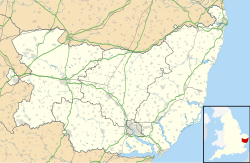| Gunton | |
|---|---|
 Pleasurewood Hills theme park | |
Location within Suffolk | |
| Population | 6,640 (2011 est.) |
| OS grid reference | TM545957 |
| Civil parish | |
| District | |
| Shire county | |
| Region | |
| Country | England |
| Sovereign state | United Kingdom |
| Post town | Lowestoft |
| Postcode district | NR32 |
| Dialling code | 01502 |
| UK Parliament | |
Gunton is a suburb of Lowestoft, in the East Suffolk district, in the English county of Suffolk. Gunton was a small coastal village, but over the years it has been suburbanised. Gunton has an estimated population of 6,640. The main A47 or Yarmouth Road runs through the area. The eastern part of Gunton, from Yarmouth Road to Gunton Cliff, is one of the most affluent parts of Lowestoft, after the North Broads area of Oulton Broad.
Contents
Hollingsworth Road, the main road through west Gunton, is named after the philanthropist Howard Hollingsworth who lived at Gunton Cliff.
Gunton was home to Roland Leighton and his family, and it is described by Vera Brittain in her First World War autobiography Testament of Youth .
